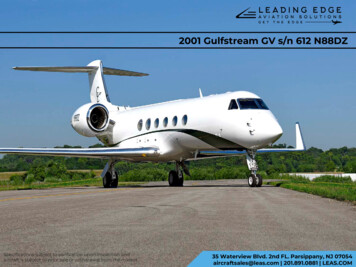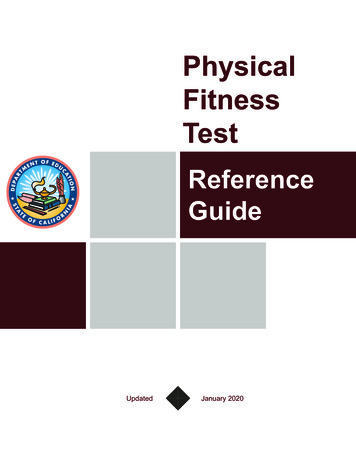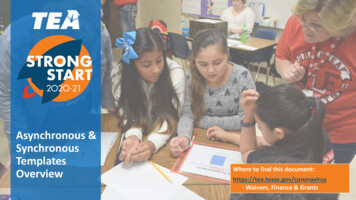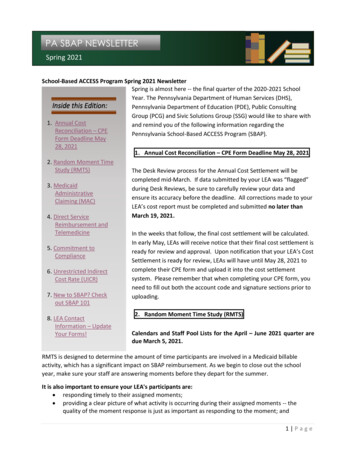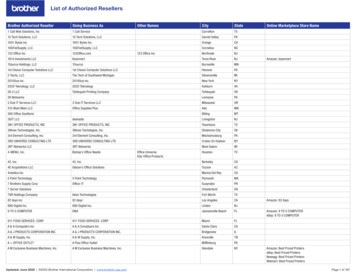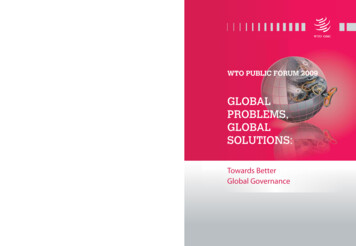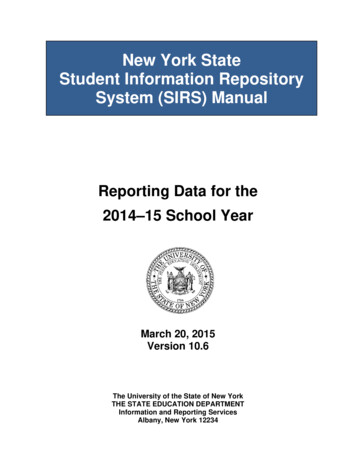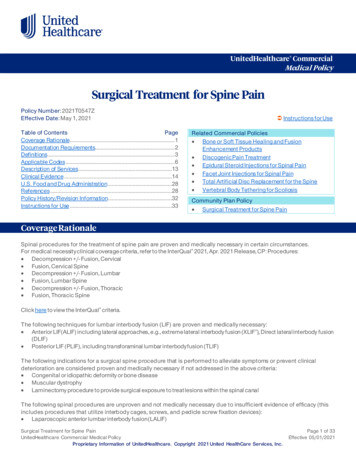
Transcription
Public Disclosure AuthorizedPublic Disclosure AuthorizedGLOBAL LEAS NG TOOLK TAn IntroductionIn Partnership tionPublic Disclosure AuthorizedPublic Disclosure Authorized
FOREWORDFOREWORDIFC has supported lease market development and institutionbuilding for 40 years through a unique combination ofinvestment and advisory products, and in partnership withour technical and development partners. Since our first andsuccessful engagement in Korea, we have invested over 1.6billion in 60 countries and advised 94 developing countrieson leasing regulations. IFC has strongly contributed to thedevelopment of the leasing industry in emerging markets andour knowledge and expertise is recognized by both private andpublic stakeholders. As a result, we increasingly emphasizeour knowledge management efforts to help synthesize andbroadly disseminate best practices and lessons learned throughpublications,andLeasing plays a critical role in promoting sustainable privatesector in emerging markets, as it particularly helps underservedmarkets, such as SMEs, to gain access to finance. Introducingleasing as an alternative source of equipment finance forenterprises promotes the development of domestic financialmarkets and encourages competition and efficiency forsustainable financial markets growth. It is a relevant productto support investments in the real and service sectors, and spurproductivity, profits, jobs and income.undesunesieddc ntiutioa corendinuteEach theteiceto briinMe fwell positioned to continue our work by developing strongWe are pleased to introduce the IFC Global Leasing Toolkit, apractical guide for entities engaged in equipment leasing forsmall and medium enterprises (SMEs). This Toolkit drawson IFC's efforts to disseminate best practices and tools inresponse to the changing landscape of the leasing industry. Itis a comprehensive working manual on how to manage andoperate a leasing entity targeting the SME market, primarilyintended for banks, non-bank financial institutions and otherleasing entities. Focused toolkits are expected to help our clientsfinancial institutions and offer sustainable leasing services toSMEs and the underserved in emerging markets. We hope thatthe Toolkit will complement a broad range of our investmentand advisory services and help build the capacity of financialinstitutions and leasing firms to set up or improve equipmentleasing.effectively respond to new market opportunities in climatechange mitigation, food security agenda, growing Islamicfinance, and optimally adapt to local conditions.development efforts on IDA countries, frontier, fragile andconflict-affected markets to reach our development goals.GfGoinnforwFareswill contiulay a majorPeer SteinGlobal Business Line LeaderAccess to Finance Advisory
2GLOBAL LEASING TOOLKIT-AN INTRODUCTION
INTRODUCTIONINTRODUCTIONObjectives of the Global Leasing ToolkitThe Globalobjectives:LeasingToolkit ("the Toolkit")has threeobjecives:While* To provide a practical guide for managers of leasing entities, especially bank-affiliated lessors, with an emphasison leasing entities offering lease products to small andmedium-sized enterprises (SMEs).* To provide a practical guide to financial institutions, businesses such as equipment suppliers and vehicle dealers, andother entities considering entering into or engaging in thebusiness of leasing equipment to SMEs.* To provide an efficient means for IFC's SME Advisory Services, as well as IFC leasing projects globally, to engage withthe management of leasing entities and other stakeholdersincluding those considering entering into leasing or investingclesing e cntiitrnitesngo netingofWho will find the Toolkit useful?the Toolkit is targeted at both bank-affiliated and nonbank lessors, especially institutions offering financing productsto SMEs, it will also be useful to business entities engaged in orconsidering engaging in leasing operations. These include privateequity institutions, microfnance institutions, equipment sellers,and manufacturers looking at leasing as a means to facilitateinstitutions (IFIs).How the Toolkit was writtenThepootines les moren ear ferecesuping equ ising enites n eergn marktsicuigbtdioySrienetadeutinvestments in leasing entities world wide, with the experiencetwo experts. These experts together have over 65 years ofThe Toolkit is a working manualexperience establishing and managing leasing entities in theUnited States, both bank-affiliated and non-bank lessors,The Toolkit is designed to be a working manual. Makingextensive use of case studies, it has been written and devisedby leasing professionals with extensive experience in foundingand extensive international advisory experience in the formerSoviet Union, the Middle East, Southeast Asia and SubSaharan Africa.and operating leasing entities, both non-bank and bankaffiliated. The information in this Toolkit is the result of yearsof practical experience of leasing professionals-both insideand outside of IFC.The Global Leasing Toolkit draws on IiC's 35 years of experiencesupporting equipment leasing entities in emerging markets.3
4GLOBAL LEASING TOOLKIT-AN INTRODUCTIONWHY THE GLOBAL LEASING TOOLKIT?However, this table also shows that Africa's market share in2008 declined, even though leasing volume in Africa increasedIn many emerging markets, the equipment leasing needs of SMEsare not being adequately addressed. Based on its long experiencedeveloping leasing in emerging markets, IFC strongly believes thesubstantially in 2008. Since Africa contains many of thepoorest countries in the world, it can reasonably be statedthat leasing activity in the poorest countries is falling behindToolkit will:the rest of the world, especially in relation to fast-growing1. Help give SMEs in emerging markets, and especially indeveloping countries, the same access to leasing-andthe same benefits from leasing-as currently enjoyedby SMEs in the United States and other industrializedcountries.countries in Asia and South America.2. Help leasing entities operating in emerging markets,and especially in developing countries, develop a profitable business, primarily but not exclusively based ona** .*Oleasing to SMEs. -- SMEs engaged in construction, including roads and bridgesAt the same time, the equipment financing needs for SMEsin emerging markets, has never been greater. The demandfor leasing in emerging markets includes, but is by no meanslimited to:- Modern equipment to meet International Product QualityesaetcnraoalntewrdonreStandardsrequiredwhen SMEs export their products top0-o:rsthe United States, Japan, or the European Union, andThe Worldwide Leasing Yearbook, as represented by thetable below, estimates 2008 world-wide leasing volume atjust over 643 billion. Between 2007 and 2008 the shareof the worldwide leasing volume represented by emerging- A 500.00 motor bike to allow a small farmer in Tajikistanor the Lao PDR to bring his produce to a local marketquickly.markets (Asia, South America, and Africa) has increased byapproximately 52 percent, from 19.5 percent in 2007 to 29.6percent in 2008.RegionLease volumePercent growthPercent of worldPercent of worldPercent change2008 ( billion)2007-2008market volumemarket volumein 48.5North outh stralia/NZ6.9(14.2)1.41.1(0.3)TOTALS643.8Source: White Clarke Global Leasing Report7.4(17.1)
INTRODUCTIONAt the same time as SME leasing needs in emerging marketsare not being adequately addressed, the leasing industry inthe United States and other industrialized countries hasaggressively expanded its SME leasing business. Today,SMEs in industrialized countries routinely lease all types ofequipment, for purposes including expanding their businessand improving the efficiency of their operations. As long asthe demand for SME leasing in emerging markets is largelyunmet, SMEs in industrialized countries will continue tohave a comparative advantage over similar SMEs in emergingmarkets especially in terms of access to leasing and utilizationof valuable working capital.The reasons leasing has become so popular among SMEs inthe United States and other industrialized countries, and willbecome the financing tool of choice for SMEs in emergingmarkets, include the following:* Businesses make money by using equipment, not by owning equipment. Leasing allows the lessee to use the cashbenefits arising from using the equipment, whether it isincreased revenues, decreased costs or both, as the primaryLeasing practitioners like to say,means to make the lease payments.* Leasing helps businesses conserve cash, which they can usefor other needs with a higher return on investment, compared to paying cash for equipment acquisitions, including hiring more employees, developing sales and markets,making bulk purchases of raw materials at a discount, andaddressing other working capital needs,when talking about the advantages of their product, "Cash isking." SMEs, no matter wherein the world they are located,must utilize their cash in areas oftheir businesses that achieve thehighest returns. Leasing is a majortool available to SMEs to help accomplish this objective.5
6GLOBAL LEASING TOOLKIT-AN INTRODUCTIONFour Emerging Market NeedsThere are four important "needs" that must be addressedbefore leasing can address the unmet demand in emergingmarkets, each discussed further below:* The need for improved financing availability* The need for improved information about the benefits ofleasing* The need to respond to market opportunities, and* The need to adapt to local conditions.The Toolkit is organized to assist users in addressing all fourneeds.Need for Improved Financing AvailabilityThe three most important considerations in accessfinancing, in descending order of importance, are these:to1. Availability-whether or not the financing is available2. Term Structure-including type of lease (finance oroperating lease), number of lease payments, paymentfrequency (seasonal, monthly), and residual payment3.Leasing helps businesses conservecash that they can use for otherneeds with a higher return oninvestment.Price-as expressed by yield or implicit rate to thelessor and, amount of each lease payment (primarily inthe case of Islamic finance)Unless financing is available (No. 1above), term structure(No. 2) and price (No. 3) are irrelevant. This is always true,regardless of the type of financing,While SMEs in the United States and other industrializedcountries have historically enjoyed almost the same financingavailability as that enjoyed by larger businesses, SMEs inemerging markets have little or no access to financial servicesand financing products. This is especially true of financingproducts with a repayment period of more than 12 months,particularly leasing. The table on the following page ("Use ofFinancial Institutions") illustrates the limited extent to whichSMEs in selected emerging markets use commercial banks fortheir financing needs and the extent to which banks requirethat borrowers put up additional collateral in return for loanextensions.
7INTRODUCTIONTable 2: Use of Financial InstitutionsCountry(&year of data)Percent of firmsusing banks tofundinvestmentsAs apercentof IFCRegionalAs apercent ofworldwidenormValue ofcollateral neededfor loan(% of loan amount)ClassificationAs apercentof IFCRegionalAs apercent )19.77151.583.7127.0989.188.1Source: World Bank Enterprise SurveysBy discussing in detail not just the universally recognizedprinciples and best practices of leasing, but also how theseprinciples and best practices are applied in emerging markets,theHowever,* serve to improve the availability of lease financing forSMEs, and* help leasing entities take advantage of a promising newmarket, namely leasing to SMEs.If there is either no information or no understanding, there isno activity.the internal procedures lessors have to undertake tooffer attractive leasing products to potential lessees are oftenvery complex. This Toolkit will largely focus on the lessor'sThere is a significant need for leasing professionals everywhere,in emerging markets as well as the developed countries, toNeed for Improved Information About theBenefits of Leasingcompletely understand the products they are responsible forselling and to explain the benefits to potential lessees. ThisIn emerging markets where there is access to financingproducts, including leasing, it is often the case that:leasing products attractive to SMEs and profitable to the leasingentity but also to assist leasing professionals in explaining the* SMEs are either unaware of the availability of lease financing or do not understand the benefits to their businessesoffered by financing products such as leasing, or both, andbenefits of leasing to their potential customers.* there is a limited ability or willingness of financial institutions-and the professionals who work in them to explainto their customers the benefits of financing products suchas leasing.Toolkit will help leasing professionals not only to develop
8GLOBAL LEASING TOOLKIT-AN INTRODUCTIONThe Need to Respond to New MarketOpportunitiesThe Need to Adapt to Local ConditionsThe leasing industry is constantly evolving in response to newmarket opportunities, especially in emerging markets. Leasingprofessionals must evolve with the industry, both by understandingtrends in the marketplace and by developing new skills to takeadvantage of the opportunities resulting from new trends.legal system and regulatory and supervisory regime in whichthey operate.To help the user develop plans to address new trends in themarketplace, the Toolkit considers in detail three marketslikely to account for a substantial amount of the future growthin the leasing industry, especially the leasing industry inemerging markets:addresses not just universally accepted leasing principles and bestpractices, but also how those principles and best practices areapplied in different legal systems and different regulatory andsupervisory regimes in use around the world. Using this approach,the Toolkit has much greater relevance to the leasing professionaloperating in a particular emerging market, who must address theparticular operational issues arising from the local legal system1. Leasing of agricultural equipment2. Leasing of equipment designed to improve efficiencyand reduce production of greenhouse gasses, and3.Islamic finance.Leasing operations can vary greatly, depending on the type ofGlobally, the leasing industry must respond to and exist withina variety of legal systems and regulatory and supervisory regimesin use throughout IFCs practice area. Therefore, the Toolkitand the particular regulatory and supervisory regime as well.
INTRODUCTIONGLOBAL LEASING TOOLKIT STRATEGYHOW THE TOOLKIT IS ORGANIZEDGiven the reasons for producing the Global Leasing Toolkitand the four emerging market needs, as described above, theToolkit strategy consists of the following five pillars:The Toolkit is organized into parts and components, based onthe "life cycle" approach just described.1. A focus on the "life cycle" of a leasing entity, from inception through funding, initial organization, and start-upoperations.2. A focus on the "life cycle" of a lease transaction, fromorigination through credit evaluation, processing, closingand servicing an existing lease.LeasiEniyadcudnn* Part III-Lease Production* Part IV-Lease Processing*Part V-Leasing Entity Operations3. A focus on specialty markets that will be major factorsin the future growth of the leasing industry in emergingmarkets, as well as a focus on how leasing operates underdifferent legal systems and regulatory and supervisoryregimes.* Glossary of Leasing Terms* Documentation Samples, Interactive Spreadsheets andWorksheets (on CD-ROM)*Focused Toolkits4. Inclusion of a complete set of sample documents that arenormally used in lease transactions, as well as documents used internally in leasing operations, interactivespreadsheets covering lease capitalization and funding,lease pricing, lease profitability, and examples of leasepricing calculations.pricng alcuatins.The5.Ease of use and distribution, through the use of an interactive CD-ROM combined with a Web portal.The "life cycle" concept is the major organizing principle ofthe Toolkit. This approach provides the user with a logical andchronological framework with which to examine particularmatters relating to both the founding and operation of a leasingParts I and II of the Toolkit focus on the life cycle of a leasingentity, while Parts III, IV and V focus primarily on the lifecycle of a lease transaction. The Base Toolkit contains leasingprinciples and best practices that are universally recognized."Focused Toolkits" apply those universal principles andbest practices to three specialty markets likely to account for asignificant portion of the future growth of leasing in emergingsakeoaderto ilearfocued tolkt desCbn howleasenties are affeedtllkystesurisorfoud in emeg markes.an eultry reentity as well as the origination, processing and servicing of alease transaction.The Toolkit makes extensive use of case studies, based onIFC's 35 years of experience in assisting and investing in leasingentities in emerging markets as well as the approximately 65years of experience of the two experts in starting and operatingleasing entities, both bank-affiliated and independent lessors.In addition The Toolkit contains a variety of interactive spreadsheets and worksheets providing the user a practical and detailedcommand of important leasing principles and best practices.The "life cycle" concept is themajor organizing principe of theGlobal Leasing Toolkit.9
10GLOBAL LEASING TOOLKIT-AN INTRODUCTIONDESCRIPTION OF THE GLOBALPart V-Lease ProcessingLEASING TOOLKIT COMPONENTSOnce a lessee says "yes" to alease proposal, that lease request isprocessed, starting with the credit process, defined as gettingthe credit officer to say "yes." Part IV includes a detailedPart I-Creating and Operating a Leasingdiscussion of credit procedures, including computation of theEntityfinancial ratios that are critical elements of the credit process,Part I focuses on the leasing entity, from inception to initiationof operations. It provides the user with a framework fordeveloping their own concept for a leasing entity and providesan outline for a business plan, and a suggested organizationchart. It also names and describes various managementpositions within a leasing entity, provides suggestions fororganizing committees, such as the credit committee, andand discussion of how to draft a credit memo for considerationby the credit officer and/or credit committee, including anexample of a credit memo.Part IV also illustrates the importance of standard leasedocuments used in lease transactions, and explains how toprepare them. Under the topic of documentation Part IV showshow to set up the proper insurance coverage and how operationaldescribes committee roles.documents are used internally to support transactions andleasing entities. Finally, Part IV covers lease servicing, portfolioPart II-Capitalizing a Leasing Entity andFunding a Lease Transactionmanagement, customer service, billing, handling of non-Part II describes alternatives available to leasing entities forPart V-Leasing Entity Operationscapitalizing their business and funding lease transactions. Thediscussion is supported by case studies and charts illustratingthe impact of capitalization and lease funding decisions. Inaddition, Part II covers the sale and purchase of lease portfolios,how portfolio sales/purchases are priced, and techniques toimprove the profitability of portfolio sales/purchases. Casestudies and worksheets serve as illustrations.performing leases, and equipment management.Sucesfulproutin an fndaetnleasing entity oprtina fficientmanaersaccounting,ithmajo emhis onmanagementaing eieasthe mesby whichthe anagenoleasitsasesses epccent onl orusIn addition Part V covers management information systems,Part Ill-Lease Productionfrom the perspective of 30 discrete leasing activities that arein all leasing entities in various forms. The objective is toPart III covers in detail lease origination and how to geta prospective lessee to say "yes." It shows how to use creditand other information to develop and refine lease products,discusses specific sales strategies and techniques, and showsdifferent methods for pricing leases so that they are bothshow the user how to decide between a number of monitoringattractive to the lessee and profitable for the lessor. Includedin pricing is a discussion of lease "mathematics" which, amongother things, introduces the tools used to price and structureManagement accounting and a management informationsystem are symbiotic. One cannot exist without the other.lease transactions. There is liberal use of case studies, as well asworksheets that show the user how to price a lease transaction.iGlossary of Leasing TermsPart li-easefoundalternatives, both automated and manual, for each discreteleasing activity. The collective decisions on how to monitoreach activity constitute a management information system.Lease management software packages are also discussed.leseOncloesingues saysies to leasinersl,the Toolktiis
INTRODUCTIONDocumentation Samples, InteractiveSpreadsheets and Worksheets (on interactiveCD-ROM)A major feature of the Toolkit that significantly enhancesits utility is its accompanying interactive CD-ROM, whichincludes a collection of many of the documents a lessor needson a daily basis. The samples include transactional documentsfor the lessee and lessor, operational documents and forms forthe lessor, and ancillary forms and documents. In Part IV, LeaseProcessing, a description is provided for each form, togetherwith the purpose and significance of the form or document.In addition, the CD-ROM includes a variety of worksheetsand spreadsheets, covering various leasing activities, includingpricing, funding decisions, and financial projections.Focused ToolkitsThe fourth focused toolkit assists the user in applyinguniversally-recognized leasing principles and best practicesin markets with different legal systems and regulatory andsupervisory regimes.in eaeaeeamese Toolkit, pplesan epacties discusedToolkiareiedtoonsiderForinIslam icina e itiarco nsidehowleaseastrutinan ingarecapitalianolean coniSharia-compliant, howIn order to facilitate its distribution and ease of updating, theentire Global Leasing Toolkit is available on CD-ROM andpresented inside a Web portal. Both the Base and focused toolkitsare also available in printed form. In order to facilitate interactivityand ease of updating, the document samples and worksheets areavailable only on CD-ROM.The objective of the four focused toolkits is to provide the userwith practical informationrelating to three specialty markets.that are expected to account for a major portion of the futuresuperv.sory.reg.mes.Successful production andgrowth of the leasing industry in emerging markets, including:* Financing of agricultural equipment* Financing of equipment designed to improve efficiency andreduce the production of greenhouse gases, andIslamic Financeprocessing of leases requiresa leasing entity to operate in anefficient manner.11
12GLOBAL LEASING TOOLKIT-AN INTRODUCTION
KEY IFC LEASING CONTACTSIFC LEASING CONTACTSAFRICA (SUB-SAHARAN)Advisory Services Contacts:David CrushRegional Business Line LeaderIFC Advisory Services, Africa4 Fricker Road, Illovo BoulevardInvestment Services Contact:Allen ForlemuSenior Investment OfficerRue Aime Cesaire x Impasse FN 18 ProlongeeDakar, SenegalEmail: AForlemu@ifc.orgIllovo 2196Johannesburg, Republic of South AfricaEmail: DCrush@ifc.orgEAST ASIA & PACIFICJonathan Danjuma GiginAdvisory Services Contacts:Operations Officer, Leasing ProgramHouse No.1 Central Link StreetSouth LegonMatthew GamserRegional Business Line LeaderITC Advisory Services, East Asia and PacificP.O. Box CT 263814th Floor, One Pacific PlaceAccra, Ghana88 Queensway, Admiralty, Hong KongEmail: JGigin@ifc.orgEmail: MGamser@ifc.orgBrian KirungiOperations Officer, Leasing ProgramCommercial Bank of Africa BuildingMara/Ragati RoadJinchang LaiPrincipal Operations OfficerIFC Advisory Services, Mekong63 Ly Thai To StreetUpper HillChengdu, ChinaNairobi, KenyaEmail: jLail@ifc.orgEmail: BKirungi@ifc.orgRiadh NaouarProgram Manager, Leasing ProgramRue Aime Cesaire x Impasse FN 18 ProlongeeDakar, SenegalEmail: RNaouar@ifc.orgOperations OfficerIFC Advisory Services, Mekong63 Ly Thai To StreetChengdu, ChinaEmail: MMal@ifc.org13
14GLOBAL LEASING TOOLKIT-AN INTRODUCTIONInvestment Services Contact:Aliou MaigaInvestment Services Contact:Manager, Financial Markets14th Floor, One Pacific Place88 Queensway, Admiralty, Hong KongEmail: AMaigal@ifc.orgTimothy M. KrauseSenior Manager, Financial MarketsBolshaya Molchanovka 36/1Moscow, Russian Federation 121069Email: TKrause@ifc.orgEUROPE AND CENTRAL ASIALATIN AMERICAAdvisory Services Contacts:Advisory Services Contacts:RolfBerndtRegional Business Line LeaderIFC Advisory Services, Europe andCentral AsiaGreta BullRegional Business Line LeaderIFC Advisory Services, Latin America andBuyukdere Cad. No: 185Kanyon Ofix Blogu, Kat: 10 Levent 34394The CaribbeanMiguel Dasso No.104Istanbul, TurkeyEmail: RBerndt@ifc.orgPiso 5, San Isidro, Lima, PerdEmail: GBull@ifc.orgRaiomand BillimoriaProject ManagerIFC Advisory Services, Europe andCentral AsiaInternational Business Center, 15th floor107 B, Amir Timur StreetTashkent 100084, UzbekistanMarco Aureio Gonzalez RevattaOperations OfficerIFC Advisory Services, Mexico CityMontes Urales 715, Piso 5Colonia Lomas de ChapultepecDelegacion Miguel HidalgoMexico, D.F., 11000 - MexicoEmail: RBillimoria@ifc.orgEmail: MGonzalezrevatta@ifc.orgPatrick LuternauerRegional Business Line LeaderIFC Advisory Services, Europe andCentral AsiaBolshaya Molchanovka 36/1Moscow, Russian Federation 121069Investment Services Contact:Giriraj S. JadejaSenior ManagerMontes Urales 715, Piso 5Colonia Lomas de ChapultepecDelegacion Miguel HidalgoEmail: PLuternauer@ifc.orgMexico, D.F., 11000-MexicoEmail: Gjadeja@ifc.org
KEY IFC LEASING CONTACTSMIDDLE EAST AND NORTH AFRICAAdvisory Services Contacts:Sayed Tarek KamalOperations OfficerIFC Advisory Services, South AsiaXavier ReilleUnitedXavirRelle10Regional Business Line LeaderHouse(4th Floor)GulshanAvenue,Gulshan 1,Dhaka 1212, BangladeshIFC Advisory Services, Middle East & North AfricaNile City Towers, N.Tower, 24th FIr, 2005CEmail: SKamall@ifc.orgCornich El Nil, Ramlet BoulacMohammad Rehan RashidProgram ManagerEmail: XReille@ifc.orgMura SulanovIFCAdvisory Services, South AsiaMurat10Operations OfficerGulshan Avenue, Gulshan 1,Dhaka 1212, BangladeshIFC Advisory Service, Middle East & North AfricaEmail: RRashid@ifc.org16, Ahmed Orabi Street, ShemeesaniAmman 11195, JordanEmail: MSultanov@ifc.orgInvestment Services Contact:Investment Services Contacts:Ayaan Z. AdamManager, Financial MarketsBilal Rabah Al Sugheyer50-M, Shani PathInvestment OfficerGate No. 3, Niti MargMiddle East & North AfricaChanakyapuriT16 Ahmed Orabi Street, ShimeisaniAmman 11193- JordanMumbai, IndiaEmail: AAdam@ifc.orgEmail: BSugheyer@ifc.orgMouayed MakhloufGLOBAL-WASHINGTON D.C., USAManager, Financial MarketsMiddle East & North AfricaAdvisory Services Contacts:10th Floor, West SideMinerva KoteiThe Gate, D.I.F.C.Global Product SpecialistDubai, United Arab EmiratesIFC Advisory Services, Access to FinanceEmail: MMakhlouf@ifc.org2121 Pennsylvania Avenue, NWWashington, DC 20433, USAEmail: MKoei@ifc.orgSOUTH ASIADoreen OppanAdvisory Services Contacts:NvarajanAntoypilaiIFCVictrVictor NavaranjanAntonypillaiConsultantAdvisory Services, Access to Finance22 enyvnaAeu,Ne043,USAssociate Operations OfficerWashintonDC15th Floor, DHPL Building,Email: DOppan@ifc.org42 Navam Mawatha,Colombo 2, Sri LankaEmail: VAntonypillai@ifc.orgPaaJennifer IsernRegional Business Line LeaderIFC Advisory Services, South AsiaIFC Advisory Services, Access to Finance2121 Pennsylvania Avenue, NWWashington, DC 20433, USA50-M, Shanti Path, Gate No. 3, Niti MargChanakyapuri, New Delhi 110 021, IndiaEmail: PVarangis@ifc.orgEmail: JOsern@ifc.orgPaul RustenarnuisInvestment Services Contact:Principal Financial SpecialistGlobal Financial Markets2121 Pennsylvania Avenue, NWWashington, DC 20433, USAEmail: PRusen@ifc.org15
.7!frr-n2121 Pennsylvania Avenue, NWWashington, DC 20433, USAwww.ifc.orgInternationalFMIlF22 CFinance CorporationWorld Bank Group
Since our first and leasing as an alternative source of equipment finance for successful engagement in Korea, we have invested over 1.6 enterprises promotes the development of domestic financial . The Global Leasing Toolkit draws on IiC's 35 years of experience supporting equipment leasing entities in emerging markets.
